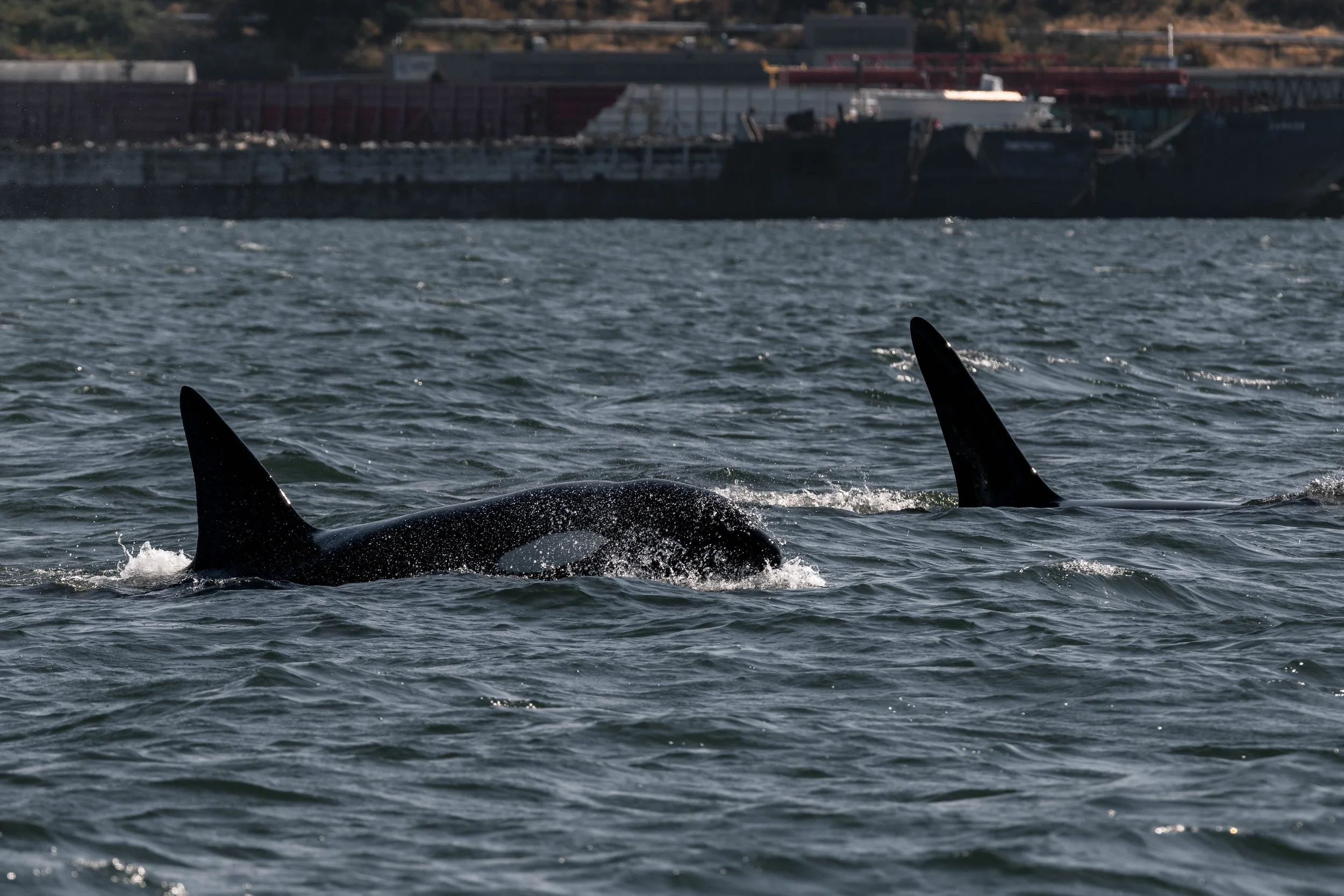July 16, 2025, 3:30 PM - The T069s right outside the Harbour
We pushed off the dock with excited guests aboard our semi-covered vessel, Kula and our open-boat Keta! With a bit of wind in the forecast, we planned to head into the shelter of the Southern Gulf Islands. Sometimes, we need to travel quite a distance to find whales, as they are wild animals with no trackers or tags, meaning every trip brings a new adventure, and we never truly know what we’ll encounter.
After a successful morning inside the Gulf Islands, we decided to try our luck there again. With no updates on the location of our morning whales, there was still a chance they could be lingering nearby. We cruised through the rippling waters of Dodd Narrows, a narrow tidal passage just south of Nanaimo that's well known for its powerful currents and dramatic tide changes. This scenic bottleneck funnels water between Vancouver Island and Mudge Island, creating whirlpools and standing waves that challenge boaters and attract a wide variety of marine life. It’s a dynamic hotspot where seals, sea lions, and bald eagles are often spotted among the swirling tides.
Just south of Dodd, we caught sight of the iconic dark dorsal fins slicing through the waves! The whales present were:
T069 Komox ♀ (~1974)
T069C Kye ♂ (1995)
T069E Kodiak ♂ (2004)
T069F Kin ♂ (2010)
One of the most beautiful aspects of observing transient orca is witnessing the strength of their family bonds, especially the relationship between a mother and her offspring. Transients, or Bigg’s killer whales, live in matrilineal pods, meaning family lines are led and passed down through the mother. These tight-knit groups typically consist of two to eight individuals, often a mother and her children, travelling and hunting together for life. However, when a pod grows larger, it’s common for daughters to branch off with their own young, forming a new matriline while still maintaining loose associations with their original family. A perfect example of this generational shift can be seen in T069 Komox. Once the central matriarch of her pod, Komox has raised two daughters, T069A Kitimat and T069D, who have since branched off to lead their own families. Watching these matrilines grow and evolve reminds us just how dynamic and complex orca society truly is.
After spending time with this remarkable family, we carried on and met another beloved member of the Salish Sea!
Harbour seal pupping season is in full swing along the coast, and if you’re lucky, you might spot a few of these adorable, speckled pups lounging on the rocks or swimming close to shore. Unlike other marine mammals that stay close to their mothers for months or even years, harbour seal pups are surprisingly independent. They’re born with a full coat of fur and can swim within minutes of birth, an essential skill for survival in the wild.
Mothers nurse their pups for just three to four weeks, during which time the pups rapidly gain weight on rich, fatty milk. After that short window, the young seals are weaned and left to navigate the ocean entirely on their own. It’s a fast and intense start to life, but these resilient little pinnipeds are well adapted to the challenges of their coastal environment.
After spending time with our most adorable member of the Salish Sea, it was time to head back home!
Photos by Aly Kohlman and Hayleigh Hilbert.
T069C Kye. Photo by Aly Kohlman.
T069C Kye with T069F Kin in tow. Photo by Aly Kohlman.
T069C Kye rushing through the waves. Photo by Aly Kohlman.
T069 Komox the matriarch. Photo by Aly Kohlman.
T069C Kye with T069F Kin coming up behind. Photo by Aly Kohlman.
T069F Kin. Photo by Aly Kohlman.
T069 Komox, T069C in the middle and T069F Kin. Photo by Aly Kohlman.
T069E Kodiak. Photo by Aly Kohlman.
T069C Kye followed by T069 Komox with T069F Kin surfacing behind. Photo by Aly Kohlman.
T069C Kye. Photo by Aly Kohlman.
T069C Kye. Photo by Aly Kohlman.
The adorable harbour seals lounging on the rocks. Photo by Aly Kohlman.
Look how cute! Photo by Aly Kohlman.
Can you spot the harbour seal pup! Photo by Aly Kohlman.
T069C Kye. Photo by Hayleigh Hilbert.
T069 Komox. Photo by Hayleigh Hilbert.
T069C Kye making waves! Photo by Hayleigh Hilbert.
How many whales can you spot? Photo by Hayleigh Hilbert.
Brothers T069C Kye with T069E Kodiak following. Photo by Hayleigh Hilbert.
T069E Kodiak. Photo by Hayleigh Hilbert.
T069C Kye with T069E Kodiak still following. Photo by Hayleigh Hilbert.
T069 Komox followed by T069F Kin. Photo by Hayleigh Hilbert.
T069C Kye showered in his own blow. Photo by Hayleigh Hilbert.
Guests on Kula watching the whales. Photo by Hayleigh Hilbert.
























